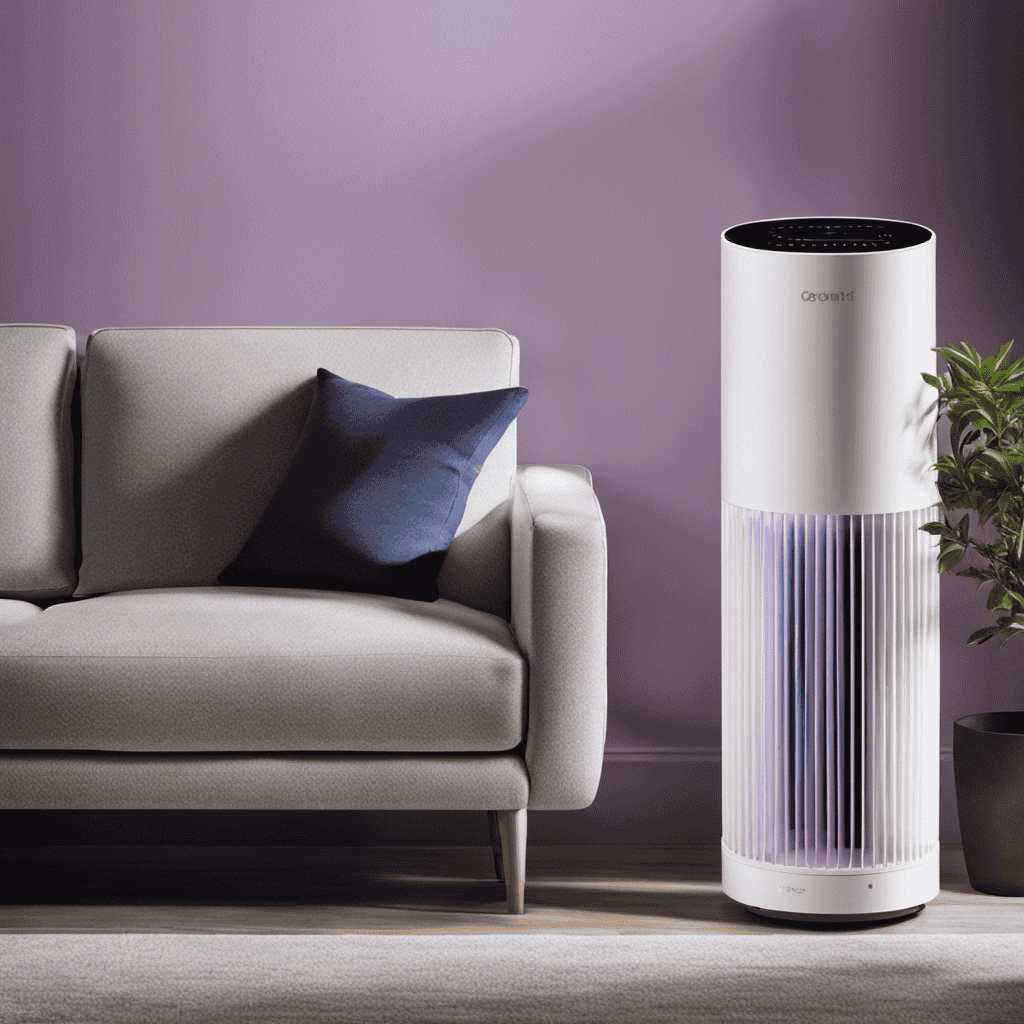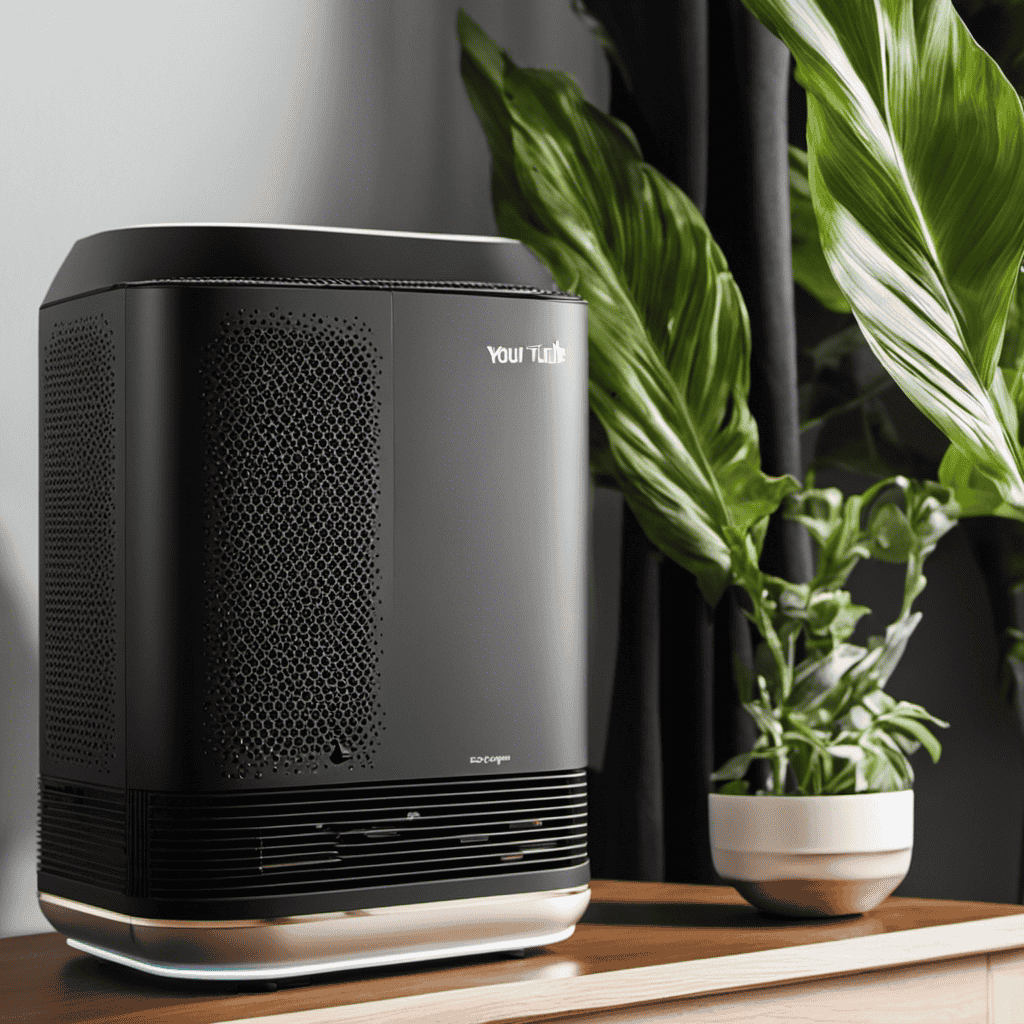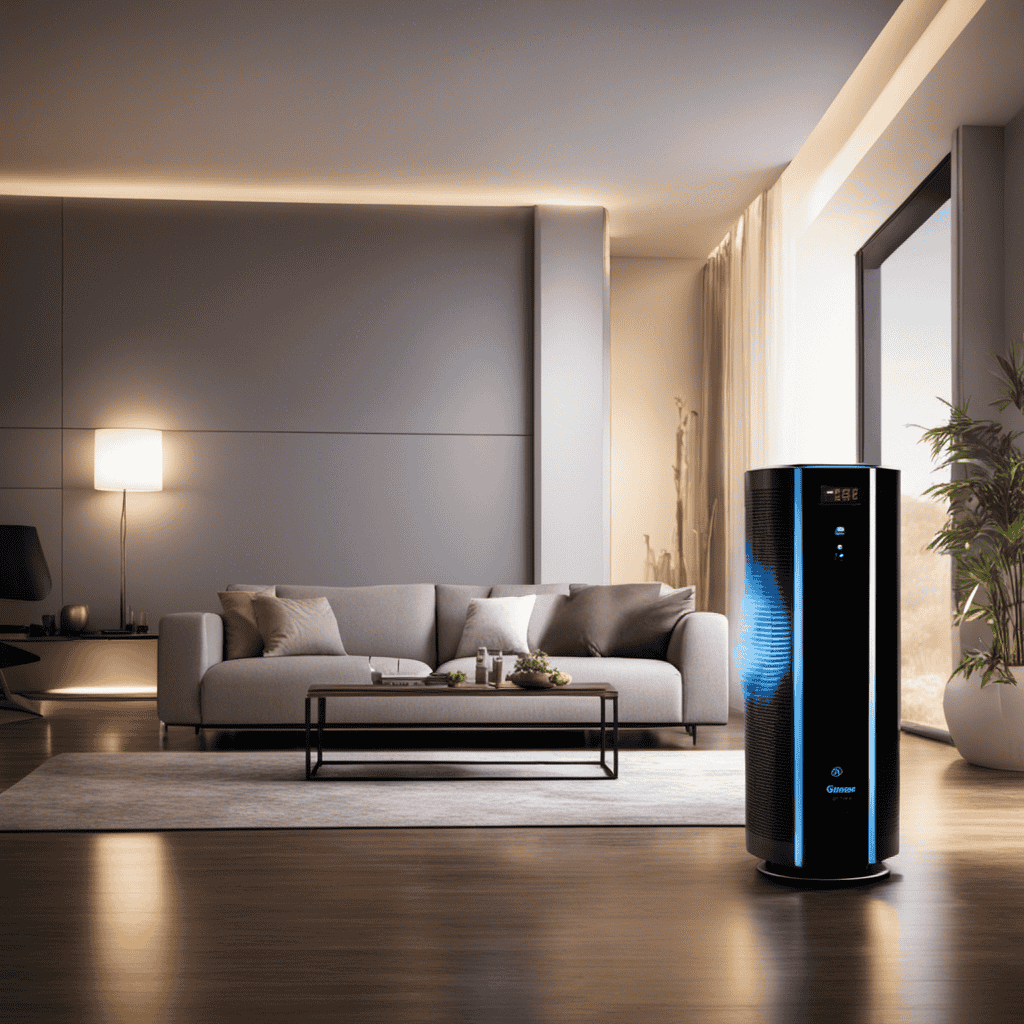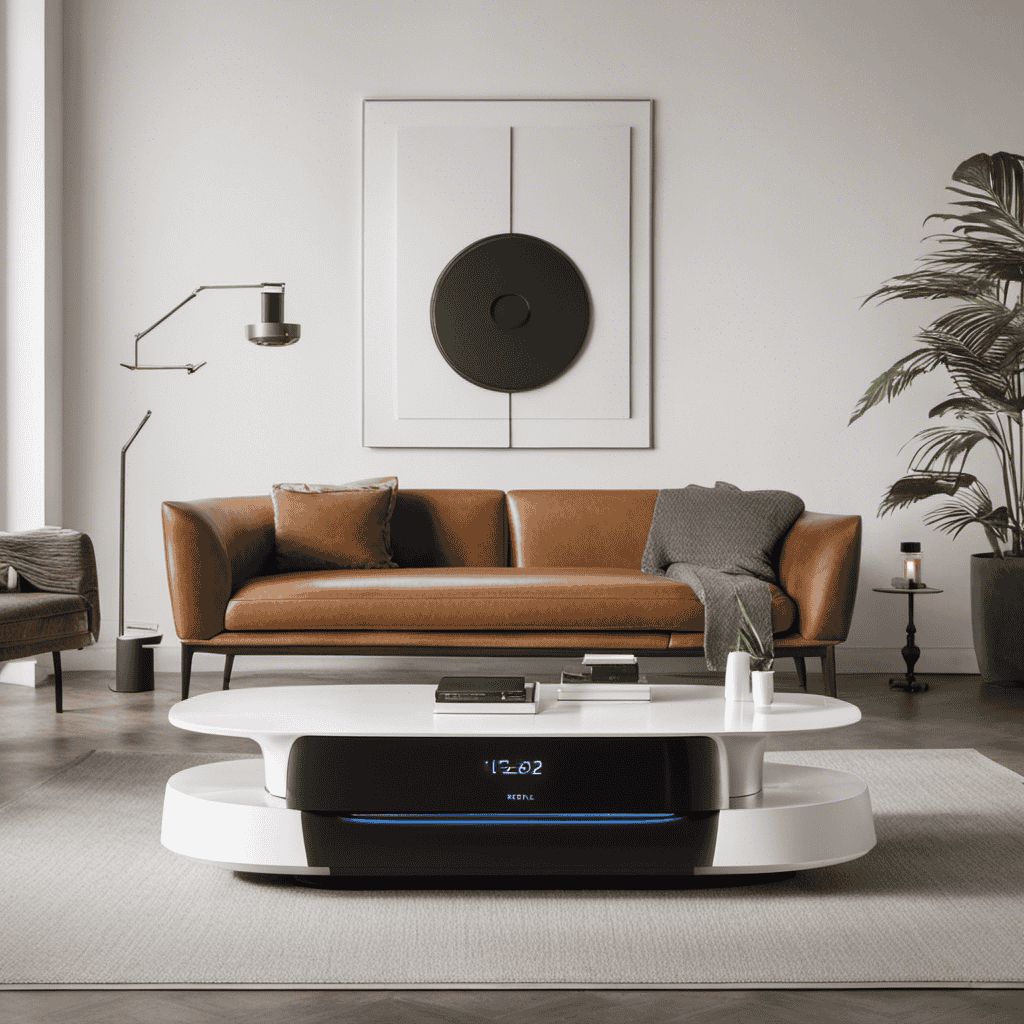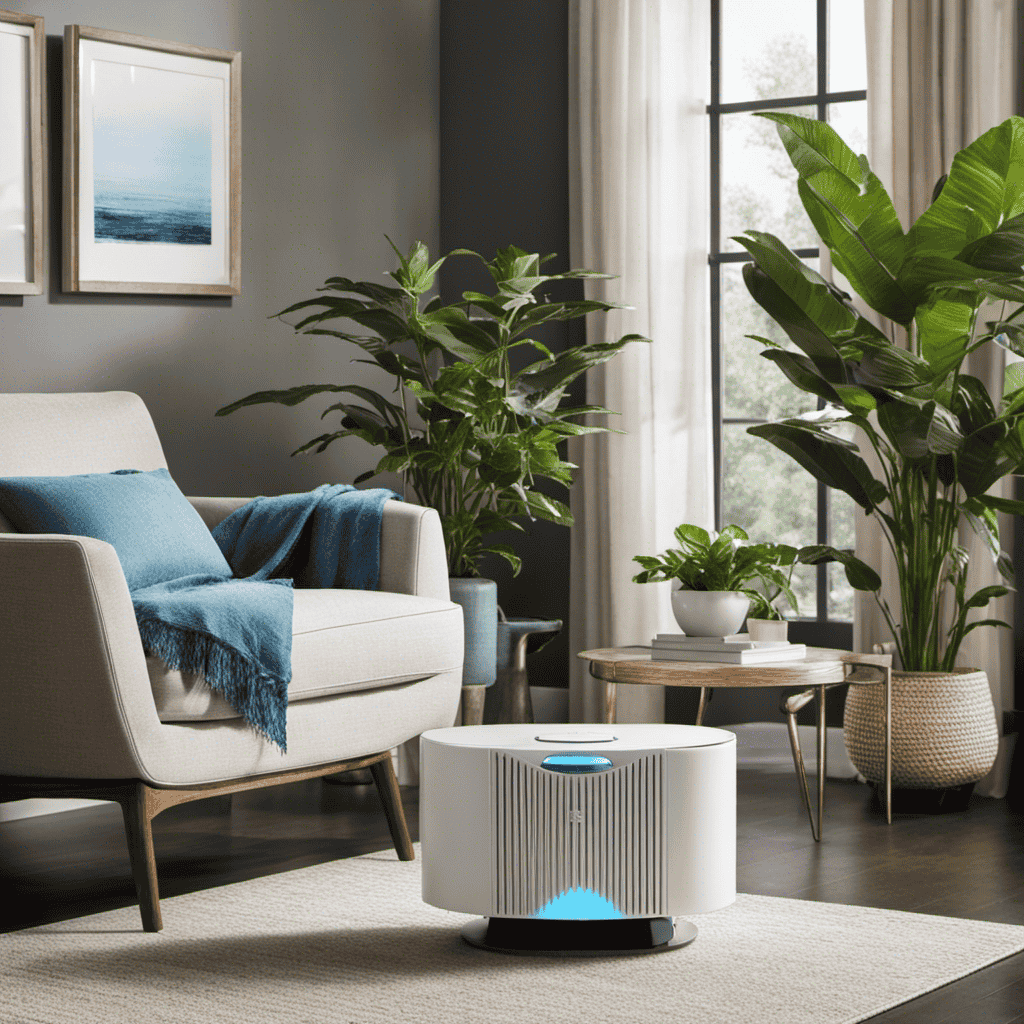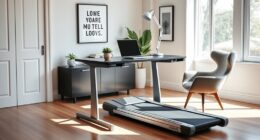I have always been curious about the effects of UV light in an air purifier. Today, I am excited to finally uncover the answers.
In this article, we will explore how UV-C technology works in air purifiers and its benefits in eliminating airborne pathogens. We’ll also compare UV-C with traditional purification methods and delve into its effectiveness in removing allergens and pollutants.
And of course, we’ll discuss safety and maintenance tips. So, if you’re curious like me, keep reading to uncover the science behind UV in air purifiers.
Key Takeaways
- UV-C light in an air purifier neutralizes harmful airborne particles.
- UV-C technology destroys the DNA and RNA of microorganisms, preventing them from reproducing and eventually causing their death.
- UV-C light effectively eliminates pathogens, providing an additional layer of protection against microscopic contaminants.
- UV-C technology in air purifiers reduces airborne pathogens, enhances air quality, neutralizes unpleasant odors, and creates a healthier living environment.
How Does UV Light Work in an Air Purifier
UV light works in an air purifier by neutralizing harmful airborne particles and killing bacteria and viruses. This technology, known as UV-C germicidal irradiation, utilizes ultraviolet wavelengths to destroy the DNA and RNA of microorganisms, rendering them unable to reproduce and causing their eventual demise.
UV light benefits in air purifiers include its ability to effectively eliminate pathogens and reduce the risk of respiratory infections, allergies, and asthma. It provides an additional layer of protection by targeting microscopic contaminants that may slip through traditional filters.
UV light technology is particularly effective against airborne viruses and bacteria, including the flu, common cold, and tuberculosis. When combined with proper filtration and ventilation, UV light in air purifiers can significantly enhance indoor air quality and promote a healthier living environment.
The Benefits of UV-C Technology in Air Purifiers
You’ll love the benefits of having UV-C technology in your air purifier. Here’s why:
-
Reduces airborne pathogens: UV-C light has been proven to effectively eliminate bacteria, viruses, and other harmful microorganisms in the air, making your indoor environment healthier and safer.
-
Enhances air quality: By targeting and destroying airborne pollutants, UV-C technology helps to improve the overall air quality in your home or office, reducing the risk of respiratory issues and allergies.
-
Odor elimination: UV-C light can neutralize unpleasant odors caused by mold, mildew, pets, or cooking, leaving your space smelling fresh and clean.
-
Long-lasting performance: UV-C bulbs have a long lifespan, ensuring that your air purifier maintains its effectiveness for an extended period of time, providing continuous protection against airborne pathogens.
Understanding the role of UV-C in airborne pathogen elimination is crucial for maximizing the benefits of this technology in your air purifier.
Understanding the Role of UV-C in Airborne Pathogen Elimination
To fully understand how UV-C technology eliminates airborne pathogens, it’s important to consider its role in creating a healthier and safer indoor environment. UV-C technology is a powerful tool used in air purifiers to effectively neutralize and destroy harmful microorganisms such as bacteria, viruses, and mold spores. By utilizing UV-C light, air purifiers can target and deactivate the DNA of these pathogens, rendering them unable to reproduce and cause harm. This process not only eliminates the immediate threat of these airborne contaminants, but also helps to prevent the spread of infectious diseases and allergies. With its ability to provide continuous air purification, UV-C technology offers numerous benefits for maintaining a clean and healthy indoor environment.
| Air Purifier Benefits | UV-C Technology |
|---|---|
| Eliminates pathogens | Yes |
| Prevents disease spread | Yes |
| Reduces allergies | Yes |
| Provides continuous purification | Yes |
| Creates a healthier indoor environment | Yes |
Understanding the effectiveness of UV-C technology in air purification is crucial when comparing it to traditional methods.
UV-C Vs. Traditional Air Purification Methods: a Comparison
When comparing UV-C technology to traditional methods, it’s important to consider the effectiveness of both in providing clean and healthy indoor air.
UV-C is a powerful tool in air purification, as it can effectively eliminate airborne pathogens and allergens. Unlike ozone-based air purification methods, UV-C does not produce harmful ozone gas, making it a safer option for indoor use.
Additionally, UV-C has been proven to have a significant impact on indoor air quality by reducing the concentration of bacteria and viruses. It works by damaging the DNA and RNA of microorganisms, rendering them unable to replicate and causing their death.
This makes UV-C an efficient and reliable method for maintaining a healthy indoor environment.
Exploring the Effectiveness of UV-C in Removing Allergens and Pollutants
In this discussion, I will be exploring the effectiveness of UV-C in removing allergens and pollutants.
UV-C, a form of ultraviolet light, has been widely studied for its ability to kill or inactivate microorganisms, including allergens and pollutants, in the air. Research has shown that UV-C can effectively eliminate a variety of allergens such as mold spores, dust mites, and pet dander, as well as pollutants like volatile organic compounds (VOCs) and bacteria.
However, the effectiveness of UV-C in air purification systems can vary depending on factors such as the intensity and duration of exposure, as well as the specific type of allergen or pollutant being targeted.
UV-C and Allergen Removal
UV-C light in air purifiers can help remove allergens from the air. This type of ultraviolet light has been shown to be effective in eliminating various allergens, such as dust mites, pet dander, and pollen.
Here are four key reasons why UV-C light is beneficial for allergen removal:
- UV-C light damages the DNA of allergens, rendering them unable to reproduce and survive.
- UV-C light breaks down volatile organic compounds (VOCs) released by allergens, reducing their impact on indoor air quality.
- UV-C light can neutralize mold spores, preventing them from spreading and causing allergic reactions.
- UV-C light can also eliminate bacteria and viruses, including those that may trigger allergic symptoms.
UV-C and Pollutant Elimination
By incorporating UV-C light, you can effectively eliminate pollutants and improve indoor air quality. UV-C light is a type of ultraviolet light that has been proven to kill or inactivate various microorganisms, including viruses and bacteria. When UV-C light is used in air purifiers, it helps to eliminate these harmful pollutants from the air, creating a healthier environment for breathing.
UV-C light works by damaging the DNA or RNA of microorganisms, preventing them from reproducing and causing harm. This makes it an effective tool in eliminating viruses and bacteria that may be present in indoor air. In fact, studies have shown that UV-C light can eliminate up to 99.9% of airborne viruses and bacteria.
Here is a table showcasing the effectiveness of UV-C light in eliminating different types of pollutants:
| Pollutant | Effectiveness of UV-C Light |
|---|---|
| Viruses | Very Effective |
| Bacteria | Very Effective |
| Mold | Effective |
| Dust | Moderate |
| Pet Dander | Moderate |
As you can see, UV-C light is highly effective in eliminating viruses and bacteria, which are major contributors to indoor air pollution. By incorporating UV-C light into air purifiers, you can greatly improve the indoor air quality of your space.
Effectiveness of UV-C
To effectively improve your indoor air quality, you should consider incorporating UV-C light into your air purification system.
UV-C technology has been proven to be highly effective in hospitals for disinfection purposes. Its ability to destroy microorganisms, including bacteria and viruses, makes it an ideal solution for reducing the spread of infections.
Additionally, UV-C light is also used in water purification systems to eliminate harmful pathogens and ensure safe drinking water. The effectiveness of UV-C in hospitals and water purification stems from its ability to disrupt the DNA and RNA of microorganisms, rendering them unable to replicate and causing their death.
UV-C Safety and Maintenance: What You Need to Know
When it comes to the effectiveness of UV-C against germs, it is important to understand the science behind its action. UV-C light has been shown to be highly effective in killing a wide range of germs, including bacteria, viruses, and mold spores.
However, it is crucial to follow proper UV-C bulb replacement guidelines to ensure that the device continues to work at its optimal level. Additionally, safety precautions must be taken when handling UV-C, as direct exposure to the light can be harmful to the skin and eyes.
UV-C Effectiveness Against Germs
UV-C is effective against germs because it penetrates their DNA, rendering them unable to reproduce. This property of UV-C light makes it an excellent tool for eliminating bacteria and other harmful microorganisms. Here are some key points to understand about the germicidal properties of UV-C:
- UV-C light damages the genetic material of germs, preventing their ability to multiply and infect.
- The wavelength of UV-C light, around 254 nanometers, is particularly effective at destroying DNA.
- UV-C light can kill up to 99.9% of bacteria and viruses in the air and on surfaces.
- Unlike chemical disinfectants, UV-C does not leave behind any residues or create resistance in germs.
Understanding the effectiveness of UV-C in germ elimination is crucial for maintaining a clean and healthy environment. However, it is important to ensure proper UV-C bulb replacement to maintain optimal performance and germ-killing capabilities.
Proper UV-C Bulb Replacement
Proper maintenance is essential for ensuring optimal performance and germ-killing capabilities of UV-C bulbs. UV-C bulbs have a limited lifespan, typically ranging from 9 to 12 months of continuous use. To maximize their effectiveness, it is crucial to replace the bulbs in a timely manner.
Regular cleaning of the bulbs is also necessary to remove dust and debris that can hinder their output. When replacing the bulbs, it is important to follow the manufacturer’s instructions to ensure proper installation.
Additionally, handling UV-C bulbs requires safety precautions due to their potential to emit harmful radiation. It is crucial to wear protective gloves and eyewear to avoid direct exposure to the UV-C light.
Safety Precautions When Handling UV-C
It’s crucial to wear protective gear, such as gloves and eyewear, when handling UV-C bulbs to prevent direct exposure to harmful radiation. UV-C bulbs emit ultraviolet radiation, which can pose serious health risks if not handled properly.
Here are some important handling precautions to keep in mind:
- Always wear gloves and eyewear to protect your skin and eyes from direct exposure to UV-C radiation.
- Handle the bulbs with care to avoid breakage, as this can release mercury and other hazardous materials.
- Avoid looking directly at the bulbs when they are turned on, as this can lead to eye damage.
- Store unused bulbs in a safe and secure location, away from children and pets.
Frequently Asked Questions
Can UV Light in an Air Purifier Kill Viruses and Bacteria?
Yes, UV light in an air purifier can effectively kill viruses and bacteria. It utilizes ultraviolet radiation to disrupt the DNA and RNA of these microorganisms, rendering them unable to reproduce and causing their eventual death.
What Is the Difference Between UV-C Technology and Traditional Air Purification Methods?
UV-C technology in air purifiers offers advantages over traditional methods like HEPA filters. It destroys harmful viruses and bacteria by damaging their DNA, ensuring a thorough purification process. This technology provides a more effective and efficient way to clean the air in your home.
Does UV-C in Air Purifiers Effectively Eliminate Allergens and Pollutants?
UV-C technology in air purifiers effectively eliminates allergens and pollutants. However, it’s important to consider the pros and cons. UV-C light can kill harmful microorganisms, but prolonged exposure can be harmful to humans.
Is UV-C Light Safe to Use in an Air Purifier?
UV-C light in air purifiers effectively kills airborne pathogens. However, there are potential health risks associated with UV-C light exposure. It is important to consider safety measures and follow manufacturer guidelines to minimize any potential harm.
What Maintenance Is Required for UV-C Components in an Air Purifier?
Maintenance tips for UV-C components in an air purifier include regular cleaning and replacement. It’s important to follow manufacturer guidelines to ensure optimal performance and minimize potential risks associated with UV-C light exposure.
Conclusion
In conclusion, UV-C technology in air purifiers is a game-changer when it comes to eliminating airborne pathogens and pollutants. Its ability to break down the DNA of microorganisms ensures a cleaner and healthier indoor environment.
Compared to traditional air purification methods, UV-C proves to be more effective in removing allergens and pollutants. However, it is important to note that regular maintenance and safety precautions are necessary to ensure optimal performance.
So, if you’re looking for an efficient and reliable air purifier, UV-C is the way to go. It’s time to embrace this cutting-edge technology and breathe in fresh, purified air.
